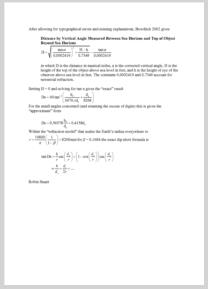
NavList:
A Community Devoted to the Preservation and Practice of Celestial Navigation and Other Methods of Traditional Wayfinding
Re: 1984 Bowditch question
From: Stan K
Date: 2016 Jul 27, 14:43 -0400
From: Stan K
Date: 2016 Jul 27, 14:43 -0400
Robin,
Wow! Nice to see that the "exact" and "refraction model" exact formulas are in agreement, at least for this one example. However, I'm getting slightly different dips, probably because the formats of the formulas are not identical (one might show a division of two constants, another might show the division already done and rounded to a certain number of significant figures):
"approximate" 2º40.45...'
"exact" 2º40.312...' or 2º40.322...', depending on which format is used
Close enough to your values, at least for government work, as they say.
FWIW, I should have stated that the claim that the "exact" formula is exact for the refraction model adopted is not from Bowditch, but from the USPS Dip Short Tables DS-84. I do not know what the source of that information was.
Stan
-----Original Message-----
From: Robin Stuart <NoReply_Stuart@fer3.com>
To: slk1000 <slk1000@aol.com>
Sent: Wed, Jul 27, 2016 1:24 pm
Subject: [NavList] Re: 1984 Bowditch question
Attached File:



From: Robin Stuart <NoReply_Stuart@fer3.com>
To: slk1000 <slk1000@aol.com>
Sent: Wed, Jul 27, 2016 1:24 pm
Subject: [NavList] Re: 1984 Bowditch question
Stan,
While I now appreciate that the accuracy of the “exact” form of the dip short formula is not your focus the claim that it is "exact" for thr refraction model adopted might be a bit of a stretch. The derivation of the Distance by Vertical Angle Measured Between Sea Horizon and Top of Object Beyond Sea Horizon formula was discussed here previously see
Refraction is introduced by increasing the Earth’s radius everywhere by a factor 1/(1- β) where β=0.1684. This is a surprising good approximation but an approximation to real refraction models nevertheless. For arguments sake let’s call it the “refraction model”. The derivation of the Distance by Vertical Angle Measured Between Sea Horizon and Top of Object Beyond Sea Horizon uses a series expansion of sine and cosine and so is not exact in that respect.
It is of course possible to calculate the dip short exactly within the “refraction model” by simple trigonometry and I’ve added the result to the bottom of the pdf file. From it we see a further inconsistency in the “exact” result. tan Ds differs from Ds by cubic terms in Ds however cubic terms in ds/r are dropped from the right hand side. However in your case of extremely close short dip Ds is large compared to ds/r the use of tan Ds would appear to be justified. Whether the formulas are accurate enough in practice to justify the use of tan Ds over Ds is another question.
In the case you cite of height of eye of 7ft and 50 yards give
“approximate” 2°40.43’
“exact” 2°40.32’
"refraction model" exact 2°40.32’
It would be pretty straightforward for someone with a theodolite to actually check how well the formulas do for a dip short at 50 yards. I understand that it standard practice in surveying to account for refraction by adjusting the Earth’s radius.
Regards,
Robin Stuart
Attached File:







